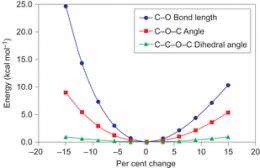November 19, 2012 report
Researchers stretch C-O bond to record length

(Phys.org)—Researchers at the University of California have succeeded in stretching a carbon monoxide molecule bond to a record length. In their paper published in the journal Nature Chemistry, the team describes how they built on previous work they'd done when building the compound oxatriquinane and noticed unusually long C-O bonds. This time around they swapped out the hydrogen surrounding the oxonium ion with other materials causing the C-O bonds to stretch to a record length of 1.622Å in ethers.
In its normal state, the C-O bond length is just 1.43Å, when present in oxatriquinane however, the bond length (also known as bond distance) is naturally stretched to 1.54Å. Bond length is the average distance between the nuclei of two atoms that are bonded together in a single molecule. The length of a bond is typically related to its order and more electrons tend to mean shorter bonds. To increase the bond length of C-O molecules in the compound oxatriquinane, the researchers replaced hydrogen surrounding the oxonium ion with alkyl groups of increasing steric demand, resulting in increased bulk. As the groups grew bigger, crowding occurred, resulting in push-back as they began to repel each other. That strain in turn resulted in stretching or pushing the C-O bonds even farther apart. Initial measurements found the bonds had been pushed to 1.60Å. A closer look using chemical synthesis and X-ray crystallography showed the bond had actually been stretched to 1.622Å. The researchers conducted a search of the Cambridge Structural Database and found no evidence that such a bond length with a C-O molecule had been observed before, which allowed them to pronounce the new length a record.
The team notes that if tert-butyloxatriquinane were attached, it meant that they had attained the greatest degree of stretching possible without causing the molecule to break apart. They add that the C-O molecule is polar and extremely fragile which meant lengthening the bond was quite an achievement.
In stretching the C-O bond, the team has helped to confirm theories that describe what happens when extraordinary strain is introduced into a molecular structure and what the limits of such experimentation might reveal.
More information: Extreme oxatriquinanes and a record C–O bond length, Nature Chemistry (2012) doi:10.1038/nchem.1502
Abstract
Oxatriquinanes are fused, tricyclic oxonium ions that are known to have exceptional stability compared to simple alkyl oxonium salts. C–O bonds in ethers are generally ∼1.43 Å in length, but oxatriquinane has been found to have C–O bond lengths of 1.54 Å. A search of the Cambridge Structural Database turned up no bona fide C–O bond length exceeding this value. Computational modelling of oxatriquinane alongside other alkyl oxonium ions indicated that the electronic consequences of molecular strain were primarily responsible for the observed bond elongation. We also show that substitution of the oxatriquinane ring system with alkyl groups of increasing steric demand pushes the C–O bond to unheard of distances, culminating in a tert-butyl derivative at a predicted 1.60 Å. Chemical synthesis and an X-ray crystallographic study of these compounds validated the results of the modelling work and, finally, an extraordinary 1.622 Å C–O bond was observed in 1,4,7-tri-tert-butyloxatriquinane.
Journal information: Nature Chemistry
© 2012 Phys.org

















